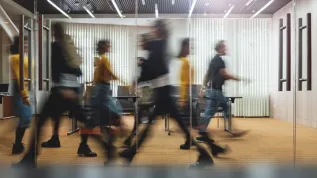
When someone panics, others can feel his concern. When others are laughing, we also find it easier to smile. Some emotions are not exclusively ours, we take them from the people in our environment. Are there structures or neural circuits in the brain that evolved specifically to ensure effective relationships with other people?
Dr. Ewelina Knapska\' team is looking for answers to these questions. The scientist conducts research under an ERC Starting Grant of the European Council 1.3 mln euros - representatives of the Nencki Institute of Experimental Biology in Warsaw told PAP.
In experiments on rats, scientists from the Nencki Institute of Experimental Biology will look at the functioning of processing centre of emotions in the brain: the amygdala.
"Our primary objective is to find out whether being infected by the emotions of others - socially transmitted emotions - engages the same group of neurons as the non-social emotions. We will also try to answer the question of whether positive and negative social emotions are processed by the same neurons" - explained Dr. Knapska.
The amygdala is a characteristic almond-shaped small structure, located deep in the brain. During direct stimulation of an individual it shows increased activity, particularly strong in the case of negative emotions, such as fear caused by a threat. It is known, however, that the amygdala is involved in the control of social emotions arising from the interaction with other emotionally aroused beings.
"With optogenetics we can control the activity of even very small portions of the amygdala in rats. Step by step, we will turn groups of neurons on and off (...) we will examine how the animal reacts to the emotions of another rat, which is nearby and which is appropriately stimulated emotionally" - explained Dr. Knapska.
Controlling specific groups of neurons is possible only in rats that have been genetically modified. As a result of these modifications, light-sensitive proteins that serve as ion channels appear in the cell membranes of selected neurons.
Before the experiment, scientists introduced into a thin optic fibre into the brain of the animal (rats tolerate the microsurgical procedure very well). When the ion channels of modified neurons are illuminated with light of a suitable wavelength, depending on their type, they will stimulate or inhibit the activity of the neuron. Responses of neurons to switching the light on or off are instant, which facilitates making the causal connection between the activity of groups of neurons and the animal\'s behaviour.
The work of Dr. Knapska\'s group is purely scientific. Due to optogenetic techniques, tests could not be carried out on the humans. However, understanding the processing of emotions in the neurons of the amygdala in rats will also have practical significance. It will allow to understand the mechanisms of various diseases, for example psychopathy and autism, in which social communication skills are strongly affected. As the underlying causes of these diseases are similar in rats and humans, the knowledge gained by Dr. Knapska\'s group about the neurobiological basis of processing social stimuli in rats will probably find medical applications over time.
"Our results so far, which allowed me to successfully apply for ERC grant, initially showed that the fear one rat indeed activates the systems of neurons in the amygdala of another animal. But the emotions transmitted socially are processed by the brain in a very complex way. Therefore, we are confident that during further experiments neurons will surprise us more than once with their reactions" - said Dr. Knapska.
Studies on the mechanisms of processing social emotions in the brain, conducted at the Nencki Institute in the framework of the ERC Starting Grant, will last five years. To complete them in the assumed date, Dr. Knapska plans to expand her group to include, among others, a postdoctoral scientist and at least two doctoral students.
Grants of the European Research Council are among the most prestigious and also the most difficult to obtain European grants. Since 2007, they have been awarded to approx. 6.5 thousand scientists, including 22 researchers from Poland.
PAP - Science and Scholarship in Poland
kol/ agt/ mrt/
tr. RL













